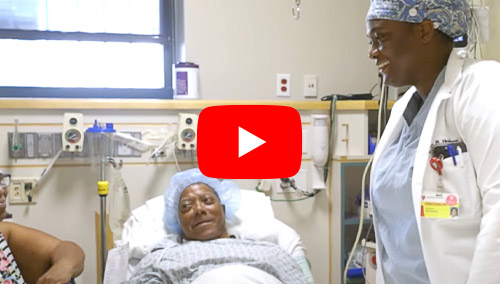Meningioma
University Hospitals Seidman Cancer Center is a national leader in the diagnosis and treatment of meningioma and other head tumors, tailoring treatment to each patient’s age, health conditions and individual needs. As one of the best cancer hospitals in the country by U.S. News & World Report for over 20 years, UH Seidman Cancer Center is part of the National Cancer Institute (NCI)-designated Case Comprehensive Cancer Center at Case Western Reserve University School of Medicine – one of an elite group of 53 such comprehensive cancer hospitals in the U.S.
Your health is important. Make an appointment today.
Offering in-person, video and telephone visits. Call todayto see which option is right for you. 216-541-1795
Learn more about virtual visits
What is a Meningioma?
A meningioma, also called a meningeal tumor, originates in the meninges – the three membranes that surround the brain and spinal cord. Meningiomas are usually benign (noncancerous), meaning they don't spread to distant parts of the body like malignant (cancerous) tumors. But due to their close proximity to the brain and spinal cord, a meningioma can still cause serious neurological problems as its grows and compress on surrounding brain tissue, nerves and blood vessels.
Meningioma is the most common type of tumor that forms in the head. In addition, they are the most common type of brain tumors diagnosed in adults, occurring more frequently than cancerous brain tumors.
What Are the Causes of Meningioma?
The underlying causes of meningiomas are not yet fully understood. However, researchers have found that a chromosomal abnormality exists in the majority of meningiomas, specifically one involving a chromosome responsible for suppressing tumor growth. This abnormality may occur spontaneously or in association with a family history of neurofibromatosis type 2 or breast cancer. Other familial syndromes that put people at higher risk for developing a meningioma include:
- Rubinstein-Taybi syndrome
- Li-Fraumeni syndrome
- Gardner syndrome
- Multiple endocrine neoplasia type 1
- Werner syndrome
Hormonal fluctuations may be involved in the development of some meningioma cases, but more research is needed to establish a definite connection. Other people at higher risk include individuals who have had radiation treatment to the head. Also, women are more significantly likely to develop meningiomas than men.
What are Meningioma Symptoms?
Meningiomas often grow slowly. Consequently, symptoms may not occur until the tumor becomes large. Also, the type of symptoms experienced depends on the location of the tumor. Possible meningioma symptoms include:
- Vision or hearing loss
- Trouble thinking clearly
- Trouble walking
- Seizures
- Loss of smell
- Arm or leg weakness
- Headaches
- Nausea
How Is a Meningioma Treated?
Meningioma treatment depends on such factors as whether the tumor is benign or malignant, location of the tumor, and the patient’s general health and preferences for potential treatment paths. Treatments include the following:
Innovative Clinical Research Leads to New Advances in Care
University Hospitals is an affiliate of Case Western Reserve University School of Medicine, a nationally recognized leader in clinical research. UH Seidman Cancer Center currently conducts a number of clinical trials for patients with meningioma and other types of head tumors, giving patients access to new and innovative therapies and treatment options.
Reasons to Choose UH Seidman Cancer Center for Meningioma Treatment
Member of the Adult Brain Tumor Consortium, a consortium of 11 elite Centers of Excellence for brain tumors.
Provides meningioma patients with innovative clinical trials
The first stereotactic radiosurgery suite in Ohio to offer Gamma Knife® technology for malignant and benign brain tumors
The first hospital in Ohio to offer proton therapy – an innovative, technologically advanced cancer treatment
The second provider east of the Mississippi to offer Medtronic’s Stealth Autoguide precision robotic platform for brain surgery
The first cancer center to offer GammaTile®, a form of radiation that dissolves in the patient’s brain after placement at the end of brain surgery
One of the leading centers in the country for minimally invasive (Laser Interstitial Thermotherapy) combined with immunotherapy
A Team of Highly Trained, Compassionate Experts
Our multidisciplinary group evaluates and reviews every tumor case so that diagnosis and treatment decisions are based on the team’s combined expertise. Together, we work through every step of cancer care, always with a cure in mind, always with a focus on obtaining the best possible outcome for the patient. Our care team comprises:
- Genetic counselors
- Medical geneticists
- Medical oncologists
- Nurse navigators
- Nurse practitioners
- Pathologists
- Radiation oncologists
- Radiologists
- Social workers
- Surgical oncologists
At UH Seidman Cancer Center, each patient’s case is presented at weekly tumor board meetings, where our team conducts a disease-specific tumor board review to ensure that all treatment options are considered.



